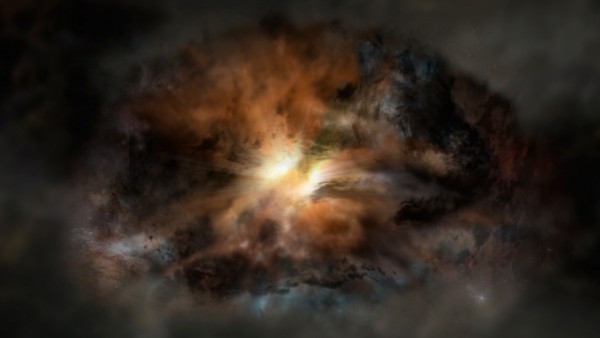By Ana Verayo, | January 17, 2016

This artist's rendering shows a galaxy called W2246-0526, the most luminous galaxy known.
The brightest known galaxy in the universe or the "most luminous galaxy" called the W2246-0526 is now emitting turbulent, massive amounts of gas, as astronomers believe that it can "rip itself apart".
New findings from NASA's Wide-field Infrared Survey Explorer (WISE) reveal data that this galaxy is now releasing the highest power output among any galaxy of the universe, that appears to shine the brightest if all the galaxies were shining from the same observable distance. Astronomers believe that this phenomenon marks the first ever of its kind.
Like Us on Facebook
According to Roberto Assef of the Universidad Diego Portales, this galaxy is now tearing itself apart, where the light particles' energy and momentum are so great that they are dispersing and forcing gas in every possible direction.
Using data from the ALMA telescope (Atacama Large Millimeter/submillimeter Array), astronomers were able to detect massive amounts of ionized carbon in a very turbulent state originating from this galaxy as this galaxy was formed after about 1 billion years following the Big Bang event.
The main culprit is apparently a supermassive black hole in the center of this galaxy which is most likely the source of this turbulent activity. When a black hole attracts surrounding gas and matter due to its powerful gravitational forces, a structure is formed around it called an accretion disk.
Friction from the disk causes intense brightness to emit from this black hole, that makes the galaxy shine so bright, to more than 300 trillion suns.
Astronomers have already encountered turbulent gas surrounding supermassive black holes before, where the cores of nearby luminous galaxies contain active galactic winds of stellar material to flow in specific directions. However, this is the first time that extremely turbulent gas is now sweeping throughout the entire galaxy.
According to Peter Eisenhardt from NASA's Jet Propulsion Laboratory, California, this "boiling gas" is not found inside the accretion disk but rather, the entire galaxy is being disturbed dramatically.
Assef says that a most likely ending to this troubled galaxy is that it will eventually blow out all its gas and dust surrounding it, exposing the accretion disk without its dust cover, revealing the quasar.
Astronomers classify this galaxy as a rare class of cosmic objects known as Hot, Dust-Obscured Galaxies or Hot DOGs which are most powerful galaxies possessing supermasive black holes in their cores. Currently, WISE has only detected one of these for every 3,000 galaxies during its observations.
-
Use of Coronavirus Pandemic Drones Raises Privacy Concerns: Drones Spread Fear, Local Officials Say

-
Coronavirus Hampers The Delivery Of Lockheed Martin F-35 Stealth Fighters For 2020

-
Instagram Speeds Up Plans to Add Account Memorialization Feature Due to COVID-19 Deaths

-
NASA: Perseverance Plans to Bring 'Mars Rock' to Earth in 2031

-
600 Dead And 3,000 In The Hospital as Iranians Believed Drinking High-Concentrations of Alcohol Can Cure The Coronavirus

-
600 Dead And 3,000 In The Hospital as Iranians Believed Drinking High-Concentrations of Alcohol Can Cure The Coronavirus

-
COVID-19: Doctors, Nurses Use Virtual Reality to Learn New Skills in Treating Coronavirus Patients







